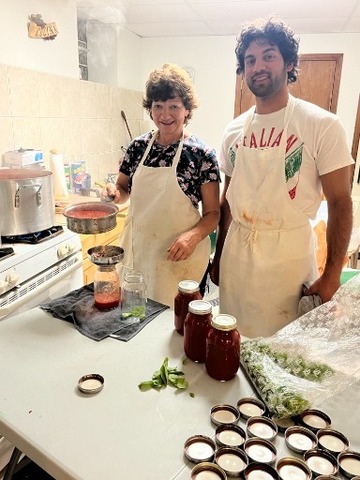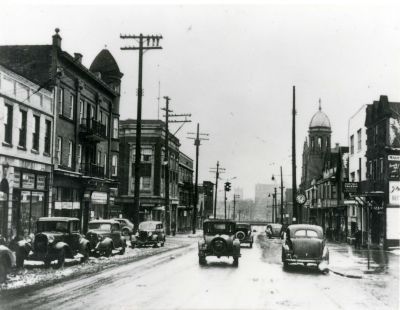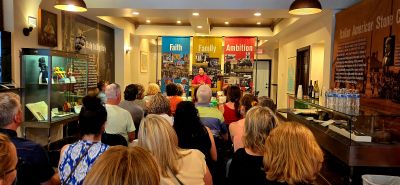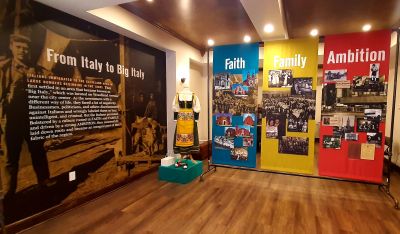
Among Ohioans, Italian ancestry is the fourth highest claimed, amounting to an estimated 684,977 people, according to 2023 Census data. Nearly 30% of them reside in Highland Heights, Cuyahoga County, located less than 15 miles northeast of Cleveland. This area was home to more than 20,000 Italian immigrants who settled between the late 19th century and 1920.
These individuals worked in construction, factories, and garment industries; established produce, stone-cutting, and landscaping trades tied to their regional skills; pioneered local manufacturing from pasta to cigars; and by the 1920s made up the majority of the city's barbers and cooks, shaping its food, labor, and cultural industries.
Today's Italian Cuyahoga County residents are increasingly far removed, many ranging from third to fifth generation Italian Americans.
The grandson of immigrants from Calvi Risorta in the Province of Caserta and Oratino in the Molise region, twenty-six-year-old Anthony Polizzi grew up much closer to his roots, claiming involvement with the Cleveland-based Unione E Fratellanza Oratinese since birth. His Oratinese maternal grandfather served as the club's president. After attending the group's Christmas parties for years, Anthony officially joined in 2016 following his receipt of a club scholarship.

Anthony and his brother with their maternal grandmother at a cousin's wedding.
His own leadership journey began when the president of Unione E Fratellanza Oratinese invited him to serve on the board to help engage younger members, and he soon became Secretary of Finance.
After attending the Italian American Future Leaders Conference in Florida, Anthony joined a local group called Little Italy Future Leaders. But something about that name felt too narrow. After all, most Italian Americans now live in the suburbs, and far fewer speak the language.
Inspired by the idea of unity and continuity, he helped establish Inizio—meaning "to start" in Italian—an organization dedicated to drawing younger generations, aged 21 to 39. While officially an Italian Sons & Daughters of America (ISDA) Lodge, the group's website messaging is clear: "Not Your Nonna's Local Lodge."
"We're trying to get the younger people involved," says Anthony, who now serves as Inizio President. "It's not just a one-time thing. You have to show up every day and participate and be active in life in what you choose to do."
We discussed what that means, how his group engages younger Italian-Americans and connects them to their heritage, Inizio's social events and activities, and the importance of promoting language, history, and traditions.
Inizio emphasizes history, heritage, and tradition—how do you ensure these values resonate with younger generations?
The age range for the club is 21 to 39. So that ensures that anybody who's coming in is going to be no more than about 20 years age difference from any other member in the club. And that brings a little bit of comfort to the people around. There are plenty of other Italian organizations you could join, but none of them are specific to this age range.
Another way we resonate with the younger audience is to have some of these more active events. We had a spring kickoff, which was quite successful because we brought homemade wine, there was homemade limoncello, and people were bringing their own drinks. It was at the Italian American Museum of Cleveland, in this open space, where you could easily network with other people, surrounded by historical pieces in the museum.
We also had a scopa night at Maxi's, where we taught how to play cards. Everyone could grab a drink. And then some people brought homemade desserts—cannoli and brownies—which we passed around.
Those types of things resonate with younger people. In June, we hosted an Italian dance workshop with Anna Harsh of the Allegro Dance Company, who traveled from Pittsburgh to Cleveland to share dances she had learned in Italy. These are active, involved experiences.

Anthony with Roman Casciani (an Inizio officer) at the Feast of the Assumption
What are some of the benefits of Inizio membership?
Especially for younger people, a significant benefit is being able to say that you're involved in things outside of just your work. You're engaged in a community: something bigger than yourself, which is not so common these days. It's easy to be involved in things online and virtually, but we're trying to host events where you can be there in person and network. There are a lot of successful Italian Americans in the Cleveland area, so this is a good opportunity for those people to meet and actually shake hands.
Outside of that, when you get your ISDA membership (since Inizio is an official Lodge of ISDA), you will receive all the benefits of being an ISDA member. The biggest of them is the newspaper that they send out. There's just a ton of good content in there, including a book review that Pamela Dorazio Dean does every month, along with Italian words and phrases and translations, lodge events and updates, and recipes—just good content around the Italian community.

What do you hope to share with the Italian American community?
I work very closely with Pamela, who serves as the Museum Director of the Italian American Museum of Cleveland, which is our headquarters. And I've also been working with Dina Vitantonio, the Chairperson for the Little Italy Block Club.
When I send out our monthly newsletters, I include not just information about our events with Inizio and ISDA, but also about events hosted by the museum and the Little Italy Block Club. The club's goal is to engage younger people, and that doesn't necessarily mean that they have to attend Inizio events; it's about any way that they can get involved.
I'm happy to promote anything in the Italian American community to get people involved. The goal at the end of the day is for people to learn more about their culture and have fun.

Anthony and his father teach his godson, Vincenzo, how to make sausage.
What would you like to share with the broader community?
Italian culture is more than just some hand signs, movie characters, or TV show personalities. What's really good to see is that the Italian community is so tight-knit. Everybody forms these really close bonds, and that's what the broader community should see.
It's not just having a meal, it's sharing a meal with other people. It's not just meeting, it's having really close connections with the people that you're meeting with. And it's very inspiring to see others who have this same goal in mind: to bring the Italian community together.
I hope to inspire the broader community as well and show what you can have when you go bigger than yourself, when you contribute to the community.
If you enjoyed this article, consider subscribing to my newsletter for more content and updates!



